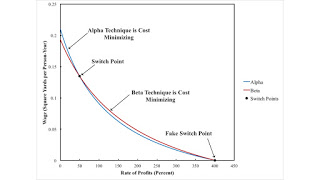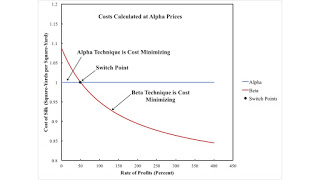Figure 1: A Switch Point and a Fake Switch Point on Wage Curves1.0 Introduction In the analysis of the choice of technique, I typically consider examples of technology with a finite number of techniques. For each technique, I find the wage as a function of the rate of profits. The outer envelope of these curves shows the cost-minimizing technique at each rate of profits (or each level of the wage). Points on more than one wage curve are switch points. This approach is valid when, for example, all techniques produce the same set of commodities, and each commodity is basic, in the sense of Sraffa. That is, all commodities enter directly or indirectly into the production of all commodities. But another requirement is that prices of all commodities in common between two techniques be
Topics:
Robert Vienneau considers the following as important: Example in Mathematical Economics, Sraffa Effects
This could be interesting, too:
Robert Vienneau writes Austrian Capital Theory And Triple-Switching In The Corn-Tractor Model
Robert Vienneau writes Double Fluke Cases For Triple-Switching In The Corn-Tractor Model
Robert Vienneau writes The Emergence of Triple Switching and the Rarity of Reswitching Explained
Robert Vienneau writes Recap For A Triple -Switching Example

|
| Figure 1: A Switch Point and a Fake Switch Point on Wage Curves |
In the analysis of the choice of technique, I typically consider examples of technology with a finite number of techniques. For each technique, I find the wage as a function of the rate of profits. The outer envelope of these curves shows the cost-minimizing technique at each rate of profits (or each level of the wage). Points on more than one wage curve are switch points.
This approach is valid when, for example, all techniques produce the same set of commodities, and each commodity is basic, in the sense of Sraffa. That is, all commodities enter directly or indirectly into the production of all commodities.
But another requirement is that prices of all commodities in common between two techniques be identical at a switch point. Points of intersection on wage curves without this property of identical prices are known as fake switch points. I have previously considered fake switch points in (an extension of) an example from Christian Bidard. In this post, I present an example of a fake switch point in an example with single production (or circulating capital) only. It is critical to this example that a non-basic commodity is the numeraire and that the techniques vary in the process used to produce a non-basic commodity.
The necessity to consider prices in the analysis of the choice of technique is, as I understand it, a critical point from Milana. I think he extends this point, though, to examples in which it cannot be used to criticize Sraffians.
2.0 TechnologyTable 1 shows the coefficients of production for this example. Coefficients of production specify inputs per unit output. Each process takes a year to complete. Inputs are totally used up in the production of the outputs.
| Input | Corn Industry | Silk Industry | |
| Alpha | Beta | ||
| Labor | 1 | 1 | 2 Person-Yrs |
| Corn | 1/5 | 3 | (38/15) Bushels |
| Silk | 0 | 0 | 0 Square-Yds |
The first produced commodity, corn, enters directly into the production of both commodities. It is a basic commodity, in the sense of Sraffa. Silk is a non-basic commodity. It does not enter, either directly or indirectly, into the production of corn.
3.0 Price EquationsI take a square yard of silk as the numeraire. The same rate of profits is assumed to be made in both industries when prices of production prevail. Labor is advanced, and wages are paid out of the net product at the end of the year.
3.1 The Alpha TechniqueThe following two equations specify prices of production for the Alpha technique:
(1/5) p1, α (1 + r) + wα = p1, α
3 p1, α (1 + r) + wα = 1
The variables are:
- r: The rate of profits.
- wα: The wage, for the Alpha technique.
- p1, α: The price of corn, for the Alpha technique.
wα(r) = (4 - r)/(19 + 14 r)
p1, α(r) = 5/(19 + 14 r)3.2 The Beta Technique
The price equations for the Beta technique are:
(1/5) p1, β (1 + r) + wβ = p1, β
(38/15) p1, β (1 + r) + 2 wβ = 1
The solution is:
wβ(r) = 3(4 - r)/[2( 31 + 16 r)]
p1, β(r) = 15/[2( 31 + 16 r)]4.0 Switch Points
Suppose, at the given rate of profits, the Alpha technique is in use and prices of production for the Alpha technique prevail. Figure 2 shows the cost of producing silk, for each process, at these prices. The advances, at the beginning of the year, for produced inputs are costed up at the going rate of profits. The cost of producing silk with the process in the Alpha technique, under these assumptions, is unity for any feasible rate of profits. Extra costs are not incurred in the Alpha technique. Neither are supernormal profits available.

|
| Figure 2: Cost of Producing Silk at Alpha Prices |
But supernormal profits are available for the silk-producing process in the Beta technique if the rate of profits is feasible and exceeds the rate of profits at the switch point. The Beta technique is cost-minimizing here, while the Alpha technique is only cost-minimizing at lower rates of profits. The same conclusion about when each technique is cost-minimizing would be drawn if one started with prices of production for the Beta technique.
The switch point occurs at a rate of profits of 50 percent. The wage is (7/52) square yards per person-years, and the price of corn is (5/26) square yards per bushel at the switch point. Prices of production are the same, at the switch point, whichever technique is used.
5.0 A Fake Switch PointFigure 1, at the top of this post, graphs the wage curves for the two techniques. Consider rates of profits that equate wages:
wα(r*) = wβ(r*)
The wage curves have two intersections. One is at the switch points, at a rate of profits of 50%. At the maximum rate of profits of 400 percent, the wage is zero. In the Alpha system, the price of corn is (1/15) square yards per bushel, while it is (3/38) square yards per bushel in the Beta system. Since, prices of production vary among techniques at the maximum rate of profits, it is not a switch point. Rather, it is a fake switch point.
6.0 ConclusionsI would like to find another example of a fake switch point in a circulating capital example with a choice of processes for producing a non-basic commodity. I want a fake switch point not at an extreme, with a wage of zero. The example in Stamatis (2001) seems not to work; maybe there is a misprint in the coefficients of production. Both techniques, however, have the structure of Sraffa's "beans".
References Heterodox
Heterodox
